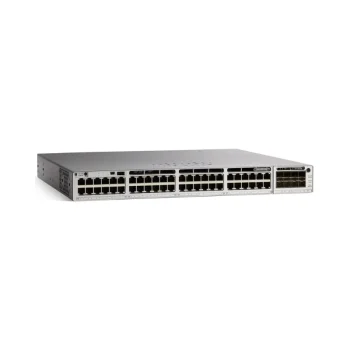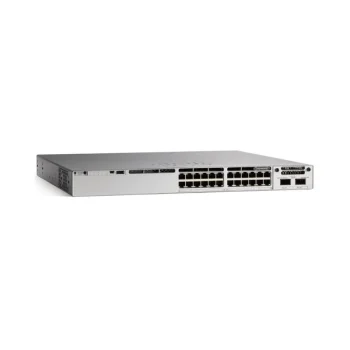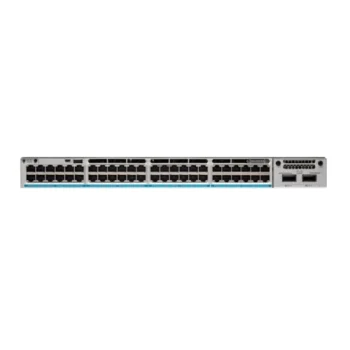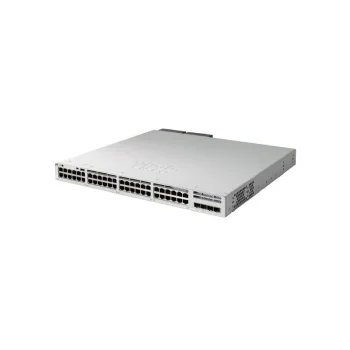Juniper QFX Series Ethernet Switch QFX5110-48S-AFI2 48 SFP+ and 4 QSFP28, back to front air flow, AC
34.525,00 AED Original price was: 34.525,00 AED.32.545,00 AEDCurrent price is: 32.545,00 AED.
- Sold By : Cloudshare Tech
- Delivery Within 7 Working Days
| Brands | JUNIPER |
|---|---|
| Condition | New |
| Warranty | 3 years |
Overview:
QFX5110 access and aggregation switches deliver low latency, rich Layer 2 and Layer 3 features, VXLAN overlay deployments, and 100GbE uplinks, making it the industry’s most nimble line of switches.
Featuring L3 gateway capabilities for bridging between virtualized and bare-metal servers, the QFX5110 is designed for extremely agile data centers that demand support for overlay/underlay network architectures. The highdensity 10GbE, 40GbE, and 100GbE ports also make the QFX5110 ideally suited for use in spine and leaf topologies.
Product Description
Data centers are rapidly adopting cloud services, whether completely off-premise models or hybrid models with critical services offered through on-premise private clouds. The tremendous growth of off-premise cloud services, coupled with the widespread adoption of overlay technologies, has created a need for highly agile switching platforms that can satisfy the demands of these evolving data centers.
The high-performance Juniper Networks QFX5110 line of Ethernet switches fit the bill, providing the foundation for dynamic data centers. As a critical enabler for IT transformation, the data center network supports cloud and SDN adoption, network virtualization, integrated/scale-out storage, and the rapid deployment and delivery of mission-critical applications that significantly increase east-west traffic within the data center. Furthermore, increasing demand for 100GbE spine ports is driving the need for 100GbE uplinks for all server access speeds, including 10GbE and 40GbE. The QFX5110 includes 100GbE uplinks, enabling it to support a diverse set of switching architectures, including fabric, Layer 3, and spine-and-leaf deployments, enabling users to easily adapt as requirements change over time.
Specifications:
| Details | |
|---|---|
| Form factor | QFX5110-48S: Fixed 1 U access/leaf
QFX5110-32Q: Fixed 1 U access/aggregation/leaf |
| Dimensions (W x H x D) | QFX5110-48S: 17.36 x x 1.72 x 20.48 in (4.37 x 44.09 x 52.02 cm)
QFX5110-32Q: 17.36 x 1.72 x 20.48 in (4.37 x 44.09 x 52.02 cm) |
| Switching capacity | QFX5110-48S: 1.76 Tbps/1.32 Bpps
QFX5110-32Q: 2.56 Tbps/1.44 Bpps |
| Port densities(10/25/40/50/100/400GbE) |
QFX5100-24Q: 24 x 40GbE QFX5100-96S: QFX5110-48S: QFX5110-32Q: |
| Power consumption | QFX5110-48S: Max load: 300W Typical load: 195W Idle load: 150W QFX5110-32Q: |
| Buffer capacity | QFX5110-48S: 16MB
QFX5110-32Q: 16MB |
| MAC addresses | 288,000 |
| IPv4 unicast/multicast routes | QFX5110-48S, QFX5110-32Q: 128,000/104,000 |
| IPv6 unicast/multicast routes | QFX5110-48S, QFX5110-32Q: 84,000/52,000 |
| Number of VLANs |
QFX5100-96S: 4,096 QFX5110-48S: 4,093 QFX5110-32Q: 4,093 |
| ARP entries | 48,000 |
| Latency | 550 ns |
| Overlay Management and Protocols | QFX5110-48S: Contrail Networking, VMware NSX L2 & L3 Gateway, VXLAN OVSDB, EVPN-VXLAN
QFX5110-32Q: Contrail Networking, VMware NSX L2 & L3 Gateway, VXLAN OVSDB, EVPN-VXLAN |
| Model: | QFX5110-48S | QFX5110-32Q |
|---|---|---|
| Dimensions (H x W x D) |
1.72 x17.36 x 20.48 in (4.37 x 44.09 x 52.02 cm) | 1.72 x17.36 x 20.48 in (4.37 x 44.09 x 52.02 cm) |
| Weight | 23 lb (10.43 kg) | 24.6 lb (11.16 kg) |
| Switching Capacity | 1.76 Tbps/1.32 Bpps | 2.56 Tbps/1.44 Bpps |
| Power Consumption | Max load: 300 W, Typical load: 195 W, Idle load: 150 W | Max load: 340 W, Typical load: 290 W, Idle load: 250 W |
| Interface Options |
|
|
| Interface Options |
|
|
| Rack Installation Kit | Versatile four post mounting options for 19-in server rack or datacom rack | |
| Airflow |
|
|
| Power Supply and Fan Modules |
|
|
| Performance Scale (Unidimensional) | ||
| MAC addresses per system | 288,000 | |
| VLAN IDs | 4,093 | |
| Number of link aggregation groups (LAGs) | 104 | |
| Number of ports per LAG | 32 | |
| Firewall filters |
|
|
| IPv4 unicast routes | 128,000 prefixes; 208,000 host routes; 64 ECMP paths | |
| IPv4 multicast routes | 104,000 | |
| IPv6 multicast routes | 52,000 | |
| IPv6 unicast routes | 84,000 prefixes | |
| ARP entries | 48,000 | |
| Jumbo frame | 9,216 bytes | |
| Spanning Tree Protocol (STP) |
|
|
| Traffic mirroring |
|
|
| Environmental Ranges | ||
| Operating temperature | 32° to 104° F (0° to 40° C) | |
| Storage temperature | -40° to 158° F (-40° to 70° C) | |
| Operating altitude | Up to 2,000 (610 m) | |
| Relative humidity operating | 5% to 90% (noncondensing) | |
| Relative humidity non-operating | 0% to 95% (noncondensing) | |
1 Measured with 10GbE passive DAC and QSFP passive DAC
2 MAC address table uses a hash-based scheme to program entries; therefore, some entries may not be programmed due to hash index collision.
3 USR optics and QFSP+ SR4 optics
Additional Feature Specifications:
Layer 2 Features
- STP—IEEE 802.1D (802.1D-2004)
- Rapid Spanning Tree Protocol (RSTP) (IEEE 802.1w); MSTP (IEEE 802.1s)
- Bridge protocol data unit (BPDU) protect
- Loop protect
- Root protect
- RSTP and VSTP running concurrently
- VLAN—IEEE 802.1Q VLAN trunking
- Routed VLAN Interface (RVI)
- Port-based VLAN
- MAC address filtering
- Private VLAN (PVLAN)
- VLAN Translation
- Static MAC address assignment for interface
- Per VLAN MAC learning (limit)
- MAC learning disable
- Link Aggregation and Link Aggregation Control Protocol (LACP) (IEEE 802.3ad)
Link Aggregation
- Multi-chassis link aggregation (MC-LAG)
- Redundant Trunk Group (RTG)
- LAG load sharing algorithm—bridged or routed (unicast or multicast) traffic:
- IP: SIP, Dynamic Internet Protocol (DIP), TCP/UDP source port, TCP/UDP destination port
- Layer 2 and non-IP: MAC SA, MAC DA, Ethertype, VLAN ID, source port
Layer 3 Features (IPv4)
- Static routing
- Routing protocols (RIP, OSPF, IS-IS, BGP)
- Virtual Router Redundancy Protocol (VRRP)
- Bidirectional Forwarding Detection (BFD) protocol
- Virtual router
- Dynamic Host Configuration Protocol (DHCP) relay
- Proxy Address Resolution Protocol (ARP)
Multicast Features
- Internet Group Management Protocol (IGMP): v1, v2 , V3
- IGMP snooping: v1, v2, and v3 (Layer 2 only)
- IGMP Filter
- PIM-SM
- Multicast Source Discovery Protocol (MSDP)
Security and Filters
- Secure interface login and password
- RADIUS
- TACACS+
- Ingress and egress filters: Allow and deny, port filters, VLAN filters, and routed filters, including management port filters
- Filter actions: Logging, system logging, reject, mirror to an interface, counters, assign forwarding class, permit, drop, police, mark
- SSH v1, v2
- Static ARP support
- Storm control, port error disable, and autorecovery
- IP source guard
- Dynamic ARP Inspection (DAI)
- Sticky MAC address
- DHCP snooping
Quality of Service (QoS)
- L2 and L3 QoS: Classification, rewrite, queuing
- Rate limiting:
- Ingress policing: 1 rate 2 color, 2 rate 3 color
- Egress policing: Policer, policer mark down action
- Egress shaping: Per queue on each port
- 12 hardware queues per port (8 unicast and 4 multicast)
- Strict priority queuing (LLQ), smoothed deficit weighted round-robin (SDWRR), weighted random early detection (WRED), weighted tail drop
- 802.1p remarking
- Layer 2 classification criteria: Interface, MAC address, Ethertype, 802.1p, VLAN
- Congestion avoidance capabilities: WRED
- Trust IEEE 802.1p (ingress)
- Remarking of bridged packets
Data Center Bridging (DCB)
- Priority-based flow control (PFC)—IEEE 802.1Qbb
- Enhanced Transmission Selection (ETS)—IEEE 802.1Qaz
- Data Center Bridging Exchange Protocol (DCBX), DCBx FCoE, and iSCSI type, length, and value (TLVs)
High Availability
- Bidirectional Forwarding Detection (BFD)
- Uplink failure detection (UFD)
MPLS
- Static label-switched paths (LSPs)
- RSVP-based signaling of LSPs
- LDP-based signaling of LSPs
- LDP tunneling (LDP over RSVP)
- MPLS class of service (CoS)
- MPLS access control list (ACL)/policers
- MPLS LSR support
- IPv6 tunneling (6PE) (via IPv4 MPLS backbone)
- IPv4 L3 VPN (RFC 2547, 4364)
Server Virtualization Management and SDN-Related Protocols
- Junos Space Virtual Control
- VXLAN OVSDB
- OpenFlow 1.3 client
Management and Operations
- Role-based CLI management and access
- CLI via console, telnet, or SSH
- Extended ping and traceroute
- Junos OS configuration rescue and rollback
- Image rollback
- SNMP v1/v2/v3
- Junos XML management protocol
- sFlow v5
- Beacon LED for port and system
- Zero-touch provisioning (ZTP)
- OpenStack Neutron Plug-in
- Python
- Junos OS event, commit, and OP scripts
Traffic Mirroring
- Port-based
- LAG port
- VLAN-based
- Filter-based
- Mirror to local
- Mirror to remote destinations (L2 over VLAN)
Standards Compliance
IEEE Standards
- IEEE standard
- IEEE 802.1D
- IEEE 802.1w
- IEEE 802.1
- IEEE 802.1Q
- IEEE 802.1p
- IEEE 802.1ad
- IEEE 802.3ad
- IEEE 802.1AB
- IEEE 802.3x
- IEEE 802.1Qbb
- IEEE 802.1Qaz
T11 Standards
- INCITS T11 FC-BB-5
Supported RFCs
- RFC 768 UDP
- RFC 783 Trivial File Transfer Protocol (TFTP)
- RFC 791 IP
- RFC 792 ICMP
- RFC 793 TCP
- RFC 826 ARP
- RFC 854 Telnet client and server
- RFC 894 IP over Ethernet
- RFC 903 RARP
- RFC 906 TFTP Bootstrap
- RFC 951 1542 BootP
- RFC 1058 Routing Information Protocol
- RFC 1112 IGMP v1
- RFC 1122 Host requirements
- RFC 1142 OSI IS-IS Intra-domain Routing Protocol
- RFC 1256 IPv4 ICMP Router Discovery (IRDP)
- RFC 1492 TACACS+
- RFC 1519 Classless Interdomain Routing (CIDR)
- RFC 1587 OSPF not-so-stubby area (NSSA) Option
- RFC 1591 Domain Name System (DNS)
- RFC 1745 BGP4/IDRP for IP—OSPF Interaction
- RFC 1772 Application of the Border Gateway Protocol in the Internet
- RFC 1812 Requirements for IP Version 4 routers
- RFC 1997 BGP Communities Attribute
- RFC 2030 SNTP, Simple Network Time Protocol
- RFC 2068 HTTP server
- RFC 2131 BOOTP/DHCP relay agent and Dynamic Host
- RFC 2138 RADIUS Authentication
- RFC 2139 RADIUS Accounting
- RFC 2154 OSPF w/Digital Signatures (Password, MD-5)
- RFC 2236 IGMP v2
- RFC 2267 Network ingress filtering
- RFC 2328 OSPF v2 (edge mode)
- RFC 2338 VRRP
- RFC 2362 PIM-SM (edge mode)
- RFC 2370 OSPF Opaque link-state advertisement (LSA) Option
- RFC 2385 Protection of BGP Sessions via the TCP Message Digest 5 (MD5) Signature Option
- RFC 2439 BGP Route Flap Damping
- RFC 2453 RIP v2
- RFC 2474 Definition of the Differentiated Services Field in the IPv4 and IPv6 Headers
- RFC 2597 Assured Forwarding PHB (per-hop behavior) Group
- RFC 2598 An Expedited Forwarding PHB
- RFC 2697 A Single Rate Three Color Marker
- RFC 2698 A Two Rate Three Color Marker
- RFC 2796 BGP Route Reflection—An Alternative to Full Mesh IBGP
- RFC 2918 Route Refresh Capability for BGP-4
- RFC 3065 Autonomous System Confederations for BGP
- RFC 3376 IGMP v3 (source-specific multicast include mode only)
- RFC 3392 Capabilities Advertisement with BGP-4
- RFC 3446, Anycast RP
- RFC 3569 SSM
- RFC 3618 MSDP
- RFC 3623 Graceful OSPF Restart
- RFC 4271 Border Gateway Protocol 4 (BGP-4)
- RFC 4360 BGP Extended Communities Attribute
- RFC 4456 BGP Route Reflection: An Alternative to Full Mesh Internal BGP (IBGP)
- RFC 4486 Subcodes for BGP Cease Notification Message
- RFC 4724 Graceful Restart Mechanism for BGP
- RFC 4812 OSPF Restart Signaling
- RFC 4893 BGP Support for Four-octet AS Number Space
- RFC 5176 Dynamic Authorization Extensions to RADIUS
- RFC 5396 Textual Representation of Autonomous System (AS) Numbers
- RFC 5668 4-Octet AS Specific BGP Extended Community
- RFC 5880 Bidirectional Forwarding Detection (BFD)
Supported MIBs
- RFC 1155 SMI
- RFC 1157 SNMPv1
- RFC 1212, RFC 1213, RFC 1215 MIB-II, Ethernet-Like MIB and TRAPs
- RFC 1850 OSPFv2 MIB
- RFC 1901 Introduction to Community-based SNMPv2
- RFC 2011 SNMPv2 for Internet protocol using SMIv2
- RFC 2012 SNMPv2 for transmission control protocol using SMIv2
- RFC 2013 SNMPv2 for user datagram protocol using SMIv2
- RFC 2233, The Interfaces Group MIB Using SMIv2
- RFC 2287 System Application Packages MIB
- RFC 2570 Introduction to Version 3 of the Internet-standard Network Management Framework
- RFC 2571 An Architecture for describing SNMP Management Frameworks (read-only access)
- RFC 2572 Message Processing and Dispatching for the SNMP (read-only access)
- RFC 2576 Coexistence between SNMP Version 1, Version 2, and Version 3
- RFC 2578 SNMP Structure of Management Information MIB
- RFC 2579 SNMP Textual Conventions for SMIv2
- RFC 2580 Conformance Statements for SMIv2
- RFC 2665 Ethernet-like interface MIB
- RFC 2787 VRRP MIB
- RFC 2790 Host Resources MIB
- RFC 2819 RMON MIB
- RFC 2863 Interface Group MIB
- RFC 2932 IPv4 Multicast MIB
- RFC 3410 Introduction and Applicability Statements for Internet Standard Management Framework
- RFC 3411 An architecture for describing SNMP Management Frameworks
- RFC 3412 Message Processing and Dispatching for the SNMP
- RFC 3413 Simple Network Management Protocol (SNMP)— (all MIBs are supported except the Proxy MIB)
- RFC 3414 User-based Security Model (USM) for version 3 of SNMPv3
- RFC 3415 View-based Access Control Model (VACM) for the SNMP
- RFC 3416 Version 2 of the Protocol Operations for the SNMP
- RFC 3417 Transport Mappings for the SNMP
- RFC 3418 Management Information Base (MIB) for the SNMP
- RFC 3584 Coexistence between Version 1, Version 2, and Version 3 of the Internet-standard Network Management Framework
- RFC 3826 The Advanced Encryption Standard (AES) Cipher Algorithm in the SNMP User-based Security Model
- RFC 4188 Definitions of Managed Objects for Bridges
- RFC 4318 Definitions of Managed Objects for Bridges with Rapid Spanning Tree Protocol
- RFC 4363b Q-Bridge VLAN MIB
Approvals
Safety
- CAN/CSA-C22.2 No. 60950-1 Information Technology Equipment—Safety
- UL 60950-1 (Second Edition) Information Technology Equipment—Safety
- IEC 60950-1 Information Technology Equipment—Safety (All country deviations): CB Scheme report
- EN 60825-1 Safety of Laser Products—Part 1: Equipment Classification
NEBS
- GR-63-Core Network Equipment, Building Systems (NEBS) Physical Protection
- GR-1089-Core EMC and Electrical Safety for Network Telecommunications Equipment
EMC
- FCC 47CFR, Part 15 Class A USA Radiated Emissions
- ICES-003 Class A
- EN 55022 Class A European Radiated Emissions
- CISPR 22 Class A
- EN 55032 Class A
- CISPR 32 Class A
- EN 55024
- CISPR 24
- EN 300 386
- VCCI Class A Japanese Radiated Emissions
- BSMI CNS 13438 Taiwan Radiated Emissions
- AS/NZS CISPR22
- AS/NZS CISPR32
Environmental Compliance
- Restriction of Hazardous Substances (ROHS) 6/6
- China Restriction of Hazardous Substances (ROHS)
- Registration, Evaluation, Authorisation and Restriction of Chemicals (REACH)
- Waste Electronics and Electrical Equipment (WEEE)
- Recycled material
- 80 Plus Silver PSU Efficiency
Telco
| Brands | JUNIPER |
|---|---|
| Condition | New |
| Warranty | 3 years |
Based on 0 reviews
|
|
|
0% |
|
|
|
0% |
|
|
|
0% |
|
|
|
0% |
|
|
|
0% |







Reviews
There are no reviews yet.